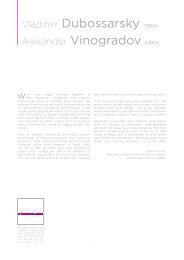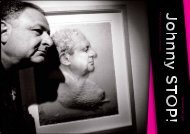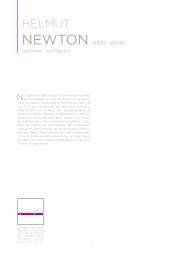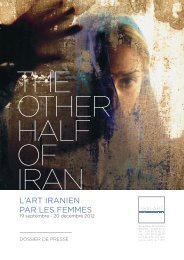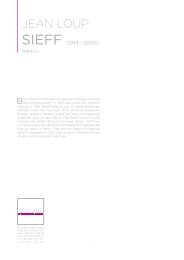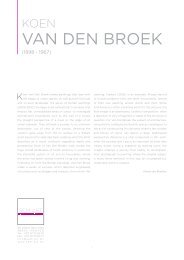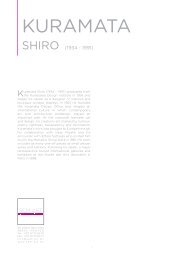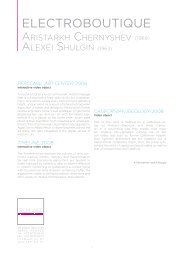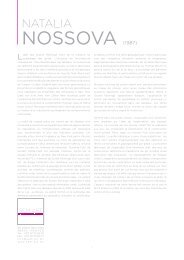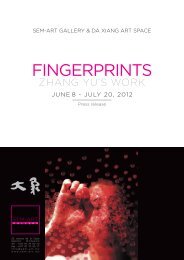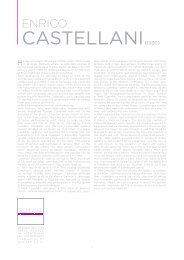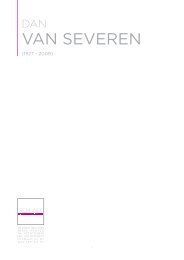Press Release - Sem Art
Press Release - Sem Art
Press Release - Sem Art
Create successful ePaper yourself
Turn your PDF publications into a flip-book with our unique Google optimized e-Paper software.
March 18 th to April 29 th 2011<br />
<strong>Press</strong> release<br />
20, avenue de la Costa<br />
98000 MONACO<br />
Tel. : +377 97 70 50 70<br />
Fax : +377 97 70 50 77<br />
info@sem-art.mc<br />
www.sem-art.mc
Russian <strong>Art</strong><br />
from March 18 th to April 29th 2011<br />
SEM-ART Gallery is pleased to present the Russian <strong>Art</strong> Exhibition. The show brings together 12 Russian artists<br />
from different generations and within a plurality of works ranging from painting and sculpture to installations and<br />
photography offers a heavy-weight overview of the Russian contemporary art.<br />
Participating artists:<br />
• Marc Chagall<br />
• Ilya and Emilia Kabakov<br />
• Erik Bulatov<br />
• Igor Makarevich and Elena Elagina<br />
• Vladimir Dubossarsky & Alexander Vinogradov<br />
• AES+F<br />
• Sergey Shekhovtsov<br />
• Electroboutique (Aristarkh Chernyshev and Alexei<br />
Shulgin)<br />
• Arseniy Zhilyaev<br />
• Sergey Bratkov<br />
• Irina Davis<br />
• Julia Zastava<br />
20, avenue de la Costa<br />
98000 MONACO<br />
Tel. : +377 97 70 50 70<br />
Fax : +377 97 70 50 77<br />
info@sem-art.mc<br />
www.sem-art.mc<br />
2
The Russian show presents a distinctive overview<br />
of established and young contemporary artists<br />
working now in Russia and abroad. Including<br />
such luminaries as Ilya and Emilia Kabakovs, Erik<br />
Bulatov, Igor Makarevich and Elena Elagina as well<br />
as young talents, the exhibition surveys how Russian<br />
contemporary artists reflect on themes inherent to<br />
the Russian situation, yet at the same time, relevant<br />
in the global cultural context. Sensitive to paradoxes<br />
and disparities of the contemporary world, Russian<br />
artists always explored these issues.<br />
The art of Ilya and Emilia Kabakovs, although originally<br />
rooted in the post-Stalinist Russia, is, nevertheless,<br />
universal in its exploration of the human condition.<br />
Presented in this exhibition is a wonderful selection<br />
of works from 1994 to 2009, which demonstrate the<br />
artists’ characteristic use of the negative space and<br />
language. The picture is never fully grasped – we see<br />
only the edges, glimpses of the object, sometimes<br />
through gaps and crevices. Only partially unveiled,<br />
the image has a sense of levity – although indicated<br />
within the reach, the feeling is that it is far, as if one<br />
is observing from the high above. The language<br />
underscores the obstructed visual – the words are<br />
used to narrate what cannot be seen.<br />
Just like the Kabakovs, Erik Bulatov is a key figure of<br />
Moscow Conceptualism, which was part of the unofficial<br />
art in the Soviet 70s. Language plays an important role<br />
in his works. The words, as if on a conveyor belt, stream<br />
out of and into his paintings with force and order. And<br />
yet, as if undermining their formal order, their message<br />
is often lyrical. The contrast is further heightened by<br />
the treatment of the background – usually filled with<br />
references to sky or water, Bulatov adds lightness and<br />
sublime dimension to his paintings that stands in stark<br />
opposition to the strict regimented shape of words.<br />
Skipping a few generations, the young artist Arseniy<br />
Zhilayev takes his cue from Moscow Conceptualists<br />
and employs language in his pieces too. His elegant<br />
sculptures are made out either from pieces of found<br />
furniture or thin MDF boards that make up sentences<br />
and phrases. Through his “writings” and installations,<br />
Zhilayev presents his concepts; the more recent ones<br />
explore the meaning of labor and its evolution in the<br />
contemporary world. The fondness for cheap and<br />
simple material provoked comparisons to the Russian<br />
art from the 70s and recently Zhilayev’s work together<br />
with some other artists was classified into a new<br />
movement – “novye skychnye” or the new boring. The<br />
tongue in cheek title underlines the new premises for<br />
opposition to big and expensive art production.<br />
If Arseniy Zhilayev engages with the more recent<br />
Russian art history, other artists feedback to the<br />
monumental heritage of the Russian avant-garde. The<br />
essential installation The Mushrooms of the Russian<br />
Avant Garde by Igor Makarevich and Elena Elagina<br />
dissects the utopian Tatlin’s Tower of the 1910s. The<br />
symbol of a utilitarian dream, Tatlin’s Monument to<br />
the Third International is placed atop flying agarics –<br />
a poisonous and hallucinogenic mushroom commonly<br />
found in all Russia’s woodland. Often a symbol of<br />
shamanism, its organic magic induces wild dreams.<br />
Tatlin’s Tower is also a symbol which is now associated<br />
with dreaming – the never realized ambitious project<br />
has become an emblem of a failed cultural revolution.<br />
In a similar manner, the two paintings included in this<br />
installation reference Kazimir Malevich’s Suprematist<br />
compositions and are flanked by rows of mushrooms.<br />
Although the artists explore the evolution of cultural<br />
signs specific to the Russian context, the shifting<br />
cultural sands is always a globally universal topic. The<br />
dream like composition by Makarevich and Elagina<br />
remind us of its semiotic elusiveness.<br />
3
The Tatlin Tower is also an inspiration for the collective<br />
Electroboutique, the first in Russia to work with net- and<br />
sci-art. Their re-interpretation of this symbol is a comment<br />
on our global technological advancement – the Tower<br />
appears as a gigantic I-phone, simultaneously hinting<br />
faintly at the new Tower of Babel. Here, both symbols<br />
have iconic status, however, as with any icon, its power<br />
carries hidden dangers and corruptions. Electroboutique<br />
presents another work in this exhibition – Commercial<br />
Protest. It is one of their earliest works exploring the<br />
consumer nature of the society. The plasma screen<br />
is made up of various brands, which mimic the shape<br />
of the viewer once he or she approaches the screen,<br />
making an interactive metaphor for the constitution of<br />
the modern human beings.<br />
Contemporary society is also commented on in the works<br />
by AES+F, a distinguished collective of Russian artists<br />
who came to be known for their slick, impressive and yet<br />
very disturbing video works, in which they analyze the<br />
dark underbelly of class, wealth and age structures. The<br />
works Europe-Europe are not an exception. Borrowing<br />
the innocence from the visual language of the European<br />
porcelain, originally produced for the enjoyment of the<br />
moneyed elite, the figurines are no longer bucolic visions<br />
but rather a wicked combination of old age symbols such<br />
as shepherds caught in unrestrained acts of love with<br />
the contemporary characters such as a policewoman or<br />
a businessman.<br />
<strong>Art</strong>ist Sergey Shekhovtsov, who represented Russia<br />
in the 53 rd Venice Biennale, exhibits works from his<br />
projects Zoo and other pieces. Using sponge as<br />
his prime material, the artist crafts brightly colored<br />
sculptures, which could be lightly termed Pop in their<br />
approach. Although made from the soft material, the<br />
sculptures are carved in a way reminiscent of wood and<br />
stone, tricking the viewer. The subjects of his sculptures<br />
are contemporary and relevant characters and heros –<br />
from ordinary girls and boys to Karl Lagerfeld.<br />
Musings and observations on the modern life are also<br />
subject of the artistic duo of Vladimir Dubossarsky and<br />
Alexander Vinogradov. Established as one of the most<br />
famous artists of the 90s for their paintings of such<br />
Hollywood stars as Arnold Schwarzenegger set in pastoral<br />
surroundings, their work has never stopped evolving.<br />
Their recent pieces are dedicated to the life around them,<br />
and specifically to the Moscow neighborhood of their<br />
studio. Effortlessly and beautifully executed, the work<br />
is suffused with their signature optimism and yet full of<br />
serenity that mature artists achieve.<br />
The painterly tradition is continued with the work of the<br />
young artist Julia Zastava. Hers is a style bordering on<br />
the dark side of surrealism. The work selected for the<br />
exhibition is part of her series on interpretation of gods<br />
from Greek mythology. The Medusa Gorgon looks like<br />
a lady from the reign of Marie-Antoinette. At the first<br />
glance, she is beautiful and seductive, but at a closer<br />
inspection her physical deformity becomes visible<br />
through skin patches and surface distortion.<br />
In a more light-hearted approach to commenting on<br />
beauty within and outside is the work by Irina Davis.<br />
Slick and professionally executed, her photographs<br />
explore the theme of “pin-up” girl, the images that are<br />
so often in demand by today’s society.<br />
And finally, standing on his own is the recent work by<br />
Sergei Bratkov, the ingenious Russian photographer.<br />
Choosing ordinary subjects to capture, his work is<br />
nevertheless threaded with beauty, be it photographs<br />
of the Russian naval officers’ debauchery or his<br />
more recent abstract works of simple, found objects<br />
on the street.<br />
Elena Evstafieva<br />
20, avenue de la Costa<br />
98000 MONACO<br />
Tel. : +377 97 70 50 70<br />
Fax : +377 97 70 50 77<br />
info@sem-art.mc<br />
www.sem-art.mc<br />
4
marc<br />
chagall (1887-1985)<br />
Chagall in twenty poems<br />
Painter and poet, a veritable master of balancing colour, is a multifaceted<br />
artist who cannot be summed up in any one exhibit.<br />
Here, however, is a collection of small formats that evoke all of<br />
the major themes that have marked his route. It is an astonishing<br />
concentration of a lifetime dedicated to creating. These painting<br />
date from the late fifties to 1982, three years before his death, and<br />
may be considered as a kind of artistic legacy. The obsessions,<br />
the leitmotifs, the figures and the silences that inhabit the world<br />
of Marc Chagall are all found there. In the same way as if an<br />
exact replica in miniature of a monumental temple were built.<br />
The temple, a place of meditation, where childhood memories<br />
and prayers are represented. And the Bible, which is «The greatest<br />
source of poetry of all time» according to the painter, is clearly<br />
present in this collection with the powerful evocation of the «King<br />
David» or in the more mysterious oil painting «The Reading,» where<br />
the significance of the writing of the Book, the sacred is perceived.<br />
The sacred always shrouds lovers in its veils, another subject<br />
dear to Chagall. In the shade of an «Flowering tree» on a blue<br />
background, they leave us to imagine their posterity, the fertility<br />
of their love with «The Yellow Bouquet» that releases its seeds.<br />
«Couple in a blue landscape»—A surrealist poem of wandering in<br />
space in search of bearings, in suspension, while sensuality, and<br />
the appeal of the flesh, are expressed in «The Nude». A painting<br />
that evokes the Song of Songs. One can almost hear the lover<br />
whisper in his fiancée’s ear «Your breasts are like pomegranates....»<br />
The limbo between reality and dream is always present. Chagall,<br />
whose «dreamlike chromaticism» can be referred to, is fond of<br />
chimeras and phantasmagoria. So, “The mermaid with red hair»<br />
talks with a yellow headed goat, while in another painting, the<br />
artist holds enormous red rooster in his arms. And what is «The<br />
white donkey» doing in the bouquet Clinging to the branches,<br />
floating among the flowers, it seems to be watching over<br />
the couple, or perhaps the village, the famous Jewish shtetl<br />
of central Europe, also present in «The green bouquet in the<br />
village sky» and hinted at in «Offering to the red sun». In this<br />
striking work, the hands reach toward each other in an élan, a<br />
desire to come together. An opening up whose need to exist<br />
is evoked in the sketch «The window». The sounds and words<br />
of the vast world are let in; we open our homes and our hearts.<br />
Acrobats and trapeze artists play an essential role in this impetus<br />
of generosity for Chagall. The circus is the place of the feat, a<br />
place where everyone gives more to offer a part of a dream, an<br />
arena where acrobats offer themselves to the crowds. Several<br />
works in this collection refer to it such as «The clown with a<br />
blue face» which beautifully illustrates the gift of self, a sort of<br />
sacrifice for public when the artist risks his life on stage.<br />
Chagall once said: «My circus pitches its Big Top in the sky.<br />
It performs among the clouds, among the chairs, or in the<br />
moon-reflecting windows.» This precious, and bright private<br />
collection, give everyone food for thought on an artist who will<br />
never stop amazing us with his vocabulary beyond any syntax,<br />
for his total freedom.<br />
20, avenue de la Costa<br />
98000 MONACO<br />
Tel. : +377 97 70 50 70<br />
Fax : +377 97 70 50 77<br />
info@sem-art.mc<br />
www.sem-art.mc<br />
6
7<br />
Marc chagall<br />
L’offrande au soleil rouge, circa. 1978<br />
16 x 22 cm<br />
Huile et encre de Chine sur carton entoilé.
Ilya & emilia<br />
Kabakov (b.1933) (b.1945)<br />
Ilya and Emilia Kabakov are Russian-born, Americanbased<br />
artists that collaborate on environments which fuse<br />
elements of the everyday with those of the conceptual.<br />
While their work is deeply rooted in the Soviet social and<br />
cultural context in which the Kabakovs came of age, their<br />
work still attains a universal significance.<br />
Ilya Kabakov was born in Dnepropetrovsk, Soviet Union,<br />
in 1933. He studied at the VA Surikov <strong>Art</strong> Academy<br />
in Moscow, and began his career as a children’s book<br />
illustrator during the 1950’s. He was part of a group of<br />
Conceptual artists in Moscow who worked outside the<br />
official Soviet art system. In 1985 he received his first<br />
solo show exhibition at Dina Vierny Gallery, Paris, and he<br />
moved to the West two years later taking up a six months<br />
residency at Kunstverein Graz, Austria. In 1988 Kabakov<br />
began working with his future wife Emilia (they were to be<br />
married in 1992). From this point onwards, all their work<br />
was collaborative, in different proportions according to<br />
the specific project involved. Today Kabakov is recognized<br />
as the most important Russian artist to have emerged<br />
in the late 20th century. His installations speak as much<br />
about conditions in post-Stalinist Russia as they do about<br />
the human condition universally.<br />
Emilia Kabakov (nee Kanevsky) was born in Dnepropetrovsk,<br />
Soviet Union, in 1945. She attended the Music College<br />
in Irkutsk in addition to studying Spanish language and<br />
literature at the Moscow University. She immigrated to<br />
Israel in 1973, and moved to New York in 1975, where she<br />
worked as a curator and art dealer.<br />
Their work has been shown in such venues as the Museum<br />
of Modern <strong>Art</strong>, the Hirshhorn Museum in Washington DC,<br />
the Stedelijk Museum in Amsterdam, Documenta IX, at the<br />
Whitney Biennial in 1997 and the State Hermitage Museum<br />
in St. Petersburg among others. In 1993 they represented<br />
Russia at the 45th Venice Biennale with their installation<br />
The Red Pavilion. The Kabakovs have also completed many<br />
important public commissions throughout Europe and<br />
have received a number of honors and awards, including<br />
the Oscar Kokoschka Preis, Vienna, in 2002 and the<br />
Chevalier des <strong>Art</strong>s et des Lettres, Paris, in 1995.<br />
The Kabakovs live and work in Long Island.<br />
Extract from:<br />
http://www.ilya-emilia-kabakov.com/index.php/<br />
about/biographical-sketch<br />
20, avenue de la Costa<br />
98000 MONACO<br />
Tel. : +377 97 70 50 70<br />
Fax : +377 97 70 50 77<br />
info@sem-art.mc<br />
www.sem-art.mc<br />
8
9<br />
Ilya & Emilia Kabakov<br />
The Hand, 2009<br />
Sculpture : 43 x 61 x 50.7 cm<br />
Plinth: 46 x 67 x 120 cm<br />
Marbre<br />
8/9
Erik<br />
Bulatov (b.1933)<br />
There is no doubt that Erik Bulatov is rooted in the<br />
Soviet world – propaganda symbols and slogans from<br />
everyday Soviet culture are regular features in his<br />
paintings and drawings. Yet it would be too simple<br />
to base an interpretation of his oeuvre solely on his<br />
nationality, especially since he moved to Paris in 1990.<br />
Nor can his latest works be seen merely as the results<br />
of a Russian emigrant’s explorations on canvas; they<br />
also address questions of depth, surface and light. His<br />
2008 painting “Je vis plus loin (ou Je continue à vivre)”,<br />
for instance, shows a highly idiosyncratic disregard<br />
for centricity. The top of the painting is dominated by<br />
a cloudy, mother-of-pearl sky; the bottom half by a<br />
landscape seen from a bird’s eye view. Between the two<br />
is a line of white Cyrillic text. The characters have two<br />
possible meanings in Russian: “I am still alive” and “I am<br />
not here, I am far away (from you), but I am alive.” The<br />
extreme one-point-perspective that stretches the end<br />
of the text into the distance, and the fact that the text is<br />
in Cyrillic and addresses a far-away audience lead one<br />
to conclude that the painting is autobiographical. At<br />
the same time, the work attests to an ongoing search<br />
for new ways of combining naturalistic and typographic<br />
elements, iconographic and semantic content, and of<br />
representing light.<br />
Erik Bulatov’s works have appeared in nearly every<br />
important exhibition on 20th century Russian art,<br />
including “RUSSIA!” at the Guggenheim Museums<br />
in New York (2005) and Bilbao (2006), and “Berlin-<br />
Moscow / Moscow-Berlin 1950–2000”, Tretyakow-<br />
Galerie, Moskau (2003), and Martin-Gropius-Bau, Berlin<br />
(2004), or „Traumfabrik Kommunismus. Die visuelle<br />
Kultur der Stalinzeit“, Schirn Kunsthalle, Frankfurt /<br />
Main (2003). He was also featured at the 43rd Venice<br />
Biennale (1988) and the Third Moscow Biennale (2009).<br />
His solo exhibitions have appeared at mamco – Musee<br />
d’art moderne et contemporain in Geneva (2009/2010)<br />
and at the Musée d’<strong>Art</strong> Moderne de la Ville de Paris<br />
(2007), at the kestnergesellschaft, Hannover (2006),<br />
and the Tretyakow-Galerie, Moskau (2003 and 2006).<br />
20, avenue de la Costa<br />
98000 MONACO<br />
Tel. : +377 97 70 50 70<br />
Fax : +377 97 70 50 77<br />
info@sem-art.mc<br />
www.sem-art.mc<br />
10
11<br />
Erik Bulatov<br />
Horizontale III, 1966-2005<br />
140 x 140 cm<br />
Oil on canvas
igor makarevich (b. 1943)<br />
& elena elagina (b. 1949)<br />
The Celestial Staircase and the Ethereal Island<br />
Imagine that we could define the terrestrial and heavenly<br />
worlds and count domestic Conceptualism among<br />
the cosmic phenomena that Russians like so much.<br />
Immediately, the magic figures of Fedorov, Tsiolkovsky, and<br />
Malevich come to mind. Their theories link 19th century<br />
materialist thought and metaphysical questions. Konstantin<br />
Tsiolkovsky, a modest provincial teacher of mathematics<br />
who suffered from deafness all his life, mentally flew away<br />
to the farthest parts of outer space. The visionary observed<br />
clouds in the shape of bright figures in the sky. In the late<br />
1920s, he wrote in his journal that he had seen the word<br />
“PARADISE” in Latin inscribed clearly in the evening sky –<br />
evidence of the utopian nature of his aspirations. He called<br />
the whole of the known universe the Ethereal Island.<br />
While maniacally designing a metal stack for interplanetary<br />
missiles, Tsiolkovsky looked for the whereabouts of God in a<br />
space measured in billions of light years. Kazimir Malevich was<br />
concerned with the same thing, with “God Is Not Overthrown”<br />
being the larger part of his fundamental theoretical writing,<br />
Suprematism. The World As Nonobjectivity. Malevich’s God<br />
disintegrating into innumerable planes of color, coalesces<br />
into one mathematical point, and explodes again, this time<br />
in the feverish geometry on his canvases. Long before<br />
Conceptualism, Malevich bulked up the weight of his texts<br />
in a bid to bring them to a critical mass. Malevich kept the<br />
majority of those texts safe from the unsafe environment<br />
of Soviet Russia in 1927, and they miraculously survived in a<br />
Berlin set ablaze by American air raids.<br />
We have thus conventionally divided the two perceptions<br />
of art into “terrestrial” and “celestial”. Shamanism knows<br />
many examples of the ascent to Heaven by stairway. The<br />
same device is used to make it easier for gods to descend to<br />
earth and for the souls of the dead to go up to Heaven. For<br />
example, on the Malay Archipelago, the Sun God is invited<br />
to descend to Earth on a stairway of seven steps. A Dayak<br />
(Dyak) witchdoctor summoned to treat a sick person puts<br />
up a ladder reaching to the ceiling in the middle of the<br />
hut, on which spirits descend upon the invitation of the<br />
witch doctor to possess him. Vladimir Tatlin’s Monument<br />
to the Third International is an example of such a Celestial<br />
Stairway. Shall we try and use this spiral stairway As was<br />
mentioned earlier, peace on Earth is still non-existent and<br />
can be found only in the imagination or hallucinations. The<br />
red mushroom, also known as Amanita muscaria or simply<br />
fly agaric, can serve as an instrument to seek this peace.<br />
Like birch and spruce, this oldest means of expanding<br />
one’s mind has been widespread throughout the current<br />
territory of Russia since the end of the Ice Age.<br />
Igor Makarevich<br />
20, avenue de la Costa<br />
98000 MONACO<br />
Tel. : +377 97 70 50 70<br />
Fax : +377 97 70 50 77<br />
info@sem-art.mc<br />
www.sem-art.mc<br />
12
13<br />
Makarevich & Elagina<br />
Mushrooms of the Russian Avant Garde, 2004-2008<br />
100 x 70 x 8 cm<br />
Wood, ceramics, canvas, acrylic
Vladimir Dubossarsky (b.1964)<br />
& Alexander vinogradov (b.1963)<br />
When they began working together in 1994, Alexander<br />
Vinogradov and Vladimir Dubossarsky threw a veritable<br />
brick through the window of the russian art world;<br />
the time being ripe for radicalism and conceptual art<br />
for Moscow. In the middle of this peaceful battlefield,<br />
both artists impose their will to launch a project in<br />
agreement with time and current fashion trends. In<br />
contrast to the radicals, their statement is neither<br />
violent nor in protest but simply covering the covers<br />
of magazines and film posters.<br />
With an aesthetic stemming from social realism<br />
(a privilege of the soviet period), their paintings<br />
illustrate a close connection to Pop <strong>Art</strong>; the central<br />
character arises from imagery of mass. With the will<br />
to fade as artists, they have decided to create public<br />
images like the social paintings of the previous<br />
century. But, the world has changed. The wall has<br />
fallen and the empire has collapsed leaving this<br />
place to a new ideology of consumption.<br />
Their social paintings have been adapted to a new<br />
reality where we see magnificent women, film actors,<br />
animals, comic strip heroes... Just as the capitalist<br />
dream extended through the entire earth, Dubossarsky<br />
and Vinogradov want to reach a global audience.<br />
Alexander Vinogradov and Vladimir Dubossarsky<br />
want to develop a transparent, understandable<br />
painting that speaks a universal language. But their<br />
works is addressed particularly to Russia. In 1994,<br />
Russia emerged out of Perestroika while a certain<br />
fear of the future remained. Everything needed to be<br />
made, but without precedent to guide them.<br />
Extract from :<br />
http://www.finearttv/en/fine-art/uncovered/<br />
dubossarsky-and-vinogradov<br />
20, avenue de la Costa<br />
98000 MONACO<br />
Tel. : +377 97 70 50 70<br />
Fax : +377 97 70 50 77<br />
info@sem-art.mc<br />
www.sem-art.mc<br />
14
15<br />
Dubossarsky & Vinogradov<br />
Cheburek, 2010<br />
145 x 195 cm<br />
Oil on canvas
AES+F<br />
Tatiana Arzamasova (b.1955)<br />
Lev Evzovich (b.1958)<br />
Evgeny Svyatsky (b.1957)<br />
Vladimir Fridkes (b.1956)<br />
Europe - Europe, 2007-2008<br />
Installation (porcelain sculpture, cabinet)<br />
The shepherdesses, dandies, ladies and cavaliers who<br />
were the traditional heroes of porcelain compositions<br />
of the 18th century play new roles in the Europe of the<br />
third millennium.<br />
The conflict between ethnic Europeans and Europe’s<br />
guests is transformed in to its complete opposite –<br />
love. Types and poses characteristic of gallant scenes<br />
are now occupied by contemporary heroes. Immigrants<br />
and police officers, skinheads and Turkish girls, business<br />
women and migrant workers, Chinese factory girls and<br />
their managers indulge in courtship.<br />
In this installation, seven porcelain compositions are<br />
arranged on the glass shelves of a Karelian birch cabinet.<br />
20, avenue de la Costa<br />
98000 MONACO<br />
Tel. : +377 97 70 50 70<br />
Fax : +377 97 70 50 77<br />
info@sem-art.mc<br />
www.sem-art.mc<br />
16
AES+F<br />
Europe-Europe, 2008<br />
214 x 90 x 45 cm<br />
Seven hand-painted porcelain figurines in an wood and class neoclassical cabinet<br />
3/7<br />
17
Sergey<br />
Shekhovtsov (b. 1969)<br />
"Animal or human being, which one is the most<br />
human " : this is the question that Sergey asks to us<br />
in his new project "Zoo". With his sculptures in sponge,<br />
he creates daily reality productions in miniature,<br />
showing our relations with animals. In a zoo, a young<br />
girl points her finger to a scared monkey in the corner<br />
of an imaginary cage. The child moans to her parents<br />
that the animal stole her toy. Yet she seems to be the<br />
aggressor, a plastic gun in hand, face to the frightened<br />
captive. By that simple little stage, the artist shows us<br />
the similarities between humans and animals, through<br />
their emotions and their behaviours, where one stands<br />
as a mirror for the other and vice-versa. Like in his<br />
previous works "Pigeons" and "Cinema", he stresses<br />
"the interaction between reality and fiction, between<br />
the one who is looking and the other who is looked at".<br />
20, avenue de la Costa<br />
98000 MONACO<br />
Tel. : +377 97 70 50 70<br />
Fax : +377 97 70 50 77<br />
info@sem-art.mc<br />
www.sem-art.mc<br />
18
19<br />
Sergey Shekhovtsov<br />
Trône, 2007<br />
200 x 70 x 70 cm<br />
Sculpture en mousse et spray
Electroboutique<br />
Alexei Shulgin (b.1963)<br />
Aristarkh Chernyshev (b. 1968)<br />
3G International, 2010<br />
Light sculpture<br />
A giant distorted iPhone 3G, shaped as Tatlin’s<br />
Monument to the 3d International. Tatlin’s work is<br />
considered one of the avant-garde icons, whereas<br />
iPhone is a bright techno-consumerist icon of today.<br />
Back in the 20’s of the last centuries avant-garde<br />
artists have invented design as a way to bring art into<br />
people’s homes. During the 20’s century designers were<br />
gradually taking artistic ideas and implementing them<br />
into product design. Today we see companies claiming<br />
their products are art objects themselves; art has to redefine<br />
its role in the society again. The Monument to<br />
3G links together the beginning and the current state of<br />
nearly a century of art-to-design dialogue and follows<br />
the strategy of re-claiming the designers’ ideas back<br />
into art.<br />
Commercial Protest, 2007<br />
Mediaobject<br />
It is difficult to protest these days against capitalism,<br />
especially if you are a member of capitalist society and<br />
enjoy all its benefits. Any convincing form of protest very<br />
soon gets appropriated by the system and starts being<br />
used for its sake: in politics, in advertisement, in design,<br />
etc. But we want to protest - and offer a new, realistic<br />
form: Commercial Protest. We protest in the form of a<br />
critical but/and commercially suitable art work.<br />
Commercial Protest reveals the essence of modern<br />
people; it shows what we are all made of. A viewer<br />
has their portrait a mosaic made out of transnational<br />
companies logos (variant: consumer goods). These<br />
images are globally recognizable and constitute the<br />
visual language of today. The supermarket cart that<br />
contains the TV set emphasizes the ugliness of the<br />
ultimately consumerist world. We protest against such<br />
state of things with this piece and set a fair price on it.<br />
20, avenue de la Costa<br />
98000 MONACO<br />
Tel. : +377 97 70 50 70<br />
Fax : +377 97 70 50 77<br />
info@sem-art.mc<br />
www.sem-art.mc<br />
20
21<br />
Electroboutique<br />
3G International, 2010<br />
Sculpture: 100 x 70 x 70 cm<br />
Podium: 80 x 80 x 10 cm<br />
Fiberglass, LEDs, transparent film, electronics
Arseniy<br />
Zhilyaev (b. 1984)<br />
Design Macht Frei<br />
Today, in our contemporary world, even when we make<br />
such routine gestures as consuming information in the<br />
Internet, getting dressed for a party, sharing photos on<br />
a social network – we turn into machines that shift and<br />
move capital. The sphere of the design became equal<br />
to that of the real production. We are used to such<br />
phrases as political design, self-design etc. The world<br />
has been almost fully designed over, there is control<br />
even where we seem and meant to have freedom and<br />
self-expression. Shelves at home can become a slogan.<br />
Home – factory of dreams. Dreams become nightmares.<br />
Design Macht Frei (white) – is a fragment of installation<br />
which explores transformations of labour.<br />
20, avenue de la Costa<br />
98000 MONACO<br />
Tel. : +377 97 70 50 70<br />
Fax : +377 97 70 50 77<br />
info@sem-art.mc<br />
www.sem-art.mc<br />
22
23<br />
Arseniy Zhilyaev<br />
Design Macht Frei , 2011<br />
228 x 66 cm<br />
Wood
Sergey<br />
Bratkov (b.1960)<br />
Born 1960 in Kharkov, Ukraine. Graduated Repin <strong>Art</strong><br />
College, Kharkov, Ukraine, 1978; Polytechnical Academy,<br />
Kharkov, Ukraine (department of industrial electronics),<br />
1983. In 1994 organized “Fast reaction group”with Boris<br />
Michailov, Sergei Salonsky and Victoria Michailova.<br />
In 2010 took the first prize of the 5th Annual All-<br />
Russian Awards in the field of contemporary visual<br />
art «Innovation» for his video installation «Balaklavsky<br />
Drive».<br />
Since 2000 lives in Moscow, Russia.<br />
Regina Gallery<br />
Selected solo exhibitions/ Expositions solos<br />
2010<br />
• Glory Days. Deichtor Hallen. Aktuelle<br />
Kunst Haus der Photographie.<br />
Hamburg, Germany<br />
• Ukraine. Pinchuk <strong>Art</strong> Centre. Kiev, Ukraine<br />
• Male games. Espacio Minimo Gallery.<br />
Madrid, Spain<br />
• How much Deweer Gallery.<br />
Otegem, Belgium<br />
2009<br />
• Balaklavsky Drive. REGINA Gallery.<br />
Moscow, Russia<br />
• GLORY DAYS. Canal de Isabel II.<br />
Madrid, Spain<br />
2008<br />
• GLORY DAYS. Fotomuseum.<br />
Winterthur, Switzerland<br />
• Searching for horizon. REGINA<br />
gallery. Moscow<br />
• Searching for horizon. Transit gallery.<br />
Mechelen, Belgium<br />
2007<br />
• BALTIC Centre for Contemporary<br />
<strong>Art</strong>. Gateshead, UK<br />
2006<br />
• Dream rooms. Deweer gallery.<br />
Otegem, Belgium<br />
• Part of my life. Moscow Museum of<br />
Contemporary <strong>Art</strong>. Moscow, Russia<br />
• SPA. REGINA gallery. Moscow, Russia<br />
• Misanthrope. Espacio Minimo Gallery.<br />
Madrid, Spain<br />
2005<br />
• S.M.A.K. Stedelijk Museum for<br />
Actuele Kunst. Ghent, Belgium<br />
• Collecti@n. Torch gallery,<br />
Amsterdam. The Netherlands<br />
2004<br />
• Seven. REGINA Gallery. Moscow, Russia<br />
• Birds. Galerie Anita Beckers.<br />
Frankfurt, Germany<br />
2003<br />
• Steelworkers. Transit Gallery.<br />
Mechelen, Belgium<br />
• Kids. Espacio Minimo Gallery. Madrid,<br />
Spain<br />
2002<br />
• My Moscow. REGINA Gallery.<br />
Moscow, Russia<br />
• www.girls.ru. LipanjePuntin Gallery.<br />
Trieste, Italy<br />
• Djeti-Kinder-Kids. Kunstverein<br />
Rosenheim. Rosenheim, Germany<br />
2000<br />
• Kids. REGINA Gallery. Moscow, Russia<br />
1997<br />
• The Daily Journal of Chicatilo. Galerie<br />
in der BrotFabrik. Berlin, Germany<br />
1995<br />
• In the Haystacks. Galerie in der<br />
BrotFabrik. Berlin, Germany<br />
1992<br />
• Forum Stadtpark. Graz, Austria<br />
Selected group exhibitions<br />
2010<br />
• <strong>Art</strong> to spend time. M’ARS Center for<br />
Contemporary <strong>Art</strong>s. Moscow, Russia<br />
• Workers&Philosophers. Moscow<br />
School of Management SKOLKOVO.<br />
Skolkovo, Moscow Region, Russia<br />
• What’s up Sea Rauma Biennale<br />
Balticum. Rauma <strong>Art</strong> Museum.<br />
Rauma, Finland<br />
• Diary of a madman. REGINA Gallery.<br />
Moscow, Russia<br />
• Futurology. Center for Contemporary<br />
Culture GARAGE. Moscow, Russia<br />
2009<br />
• Russian Lettrism. Central House of<br />
<strong>Art</strong>ist. Moscow, Russia<br />
• Future depends on you. New Rules.<br />
Moscow Museum of Modern <strong>Art</strong>.<br />
Moscow, Russia<br />
2007<br />
• Russia, The life and adventures of<br />
shed number XII. Collins Building.<br />
Miami, USA<br />
• 15 anos tiene mi amor. Galeria<br />
Espacio Minimo. Madrid, Spain<br />
• So Close/So Far Away. Be PART.<br />
Waregem, Belgium<br />
• Vagina is my motherland. 52th<br />
Venice Biennale. Ukrainian Pavilion.<br />
Venice, Italy<br />
• On Geekdom. Parallel project of<br />
<strong>Art</strong> Athina. Curated by V.Misiano.<br />
Athens, Greece<br />
• 2nd Moscow bienalle. Moscow, Russia<br />
2004<br />
• Manifesta5. San Sebastian, Spain<br />
• Moscow-Berlin 1950-2000. Central<br />
Historical Museum. Moscow, Russia<br />
2003<br />
• Berlin-Moscow 1950-2000. Martin-<br />
Gropius-Bau. Berlin, Germany<br />
• 50th Venice Biennale. Russian<br />
Pavilion. Venice, Italy<br />
• Horizons of Reality. MUHKA Museum of<br />
Contemporary art. Antwerp, Belgium<br />
2002<br />
• Sans Consentement. CAN. Neuchatel,<br />
Switzerland<br />
• Shock&Show. Group 78. Trieste, Italy<br />
• 25th Sao Paolo Bienal. Sao Paolo,<br />
Brasil<br />
2001<br />
• Winter Exhibition. Institute of Visual<br />
<strong>Art</strong>s. University of Wisconsin.<br />
Milwaukee, USA<br />
1999<br />
• After the Wall. Moderna Museet.<br />
Stockholm, Sweden<br />
• 3rd Triennale of Photography.Graz,<br />
Austria<br />
• Regards sur l’Ukraine.Passage du<br />
Retz. Paris, France<br />
• The Future is Now. Ukrainian <strong>Art</strong> of<br />
90s. Museum of Contemporary <strong>Art</strong>.<br />
Zagreb, Croatia<br />
1995<br />
• If I Were A German (Mikhailov, Solonsky,<br />
Bratkov). Galerie Andreas Weiss.<br />
• Galerie in der BrotFabrik. Berlin,<br />
Germany<br />
• Project for Europe. Turbine Hall.<br />
Copenhagen, Denmark<br />
Public collections/ Collectios publiques<br />
• MUHKA Museum of Contemporary<br />
<strong>Art</strong>. Antwerp, Belgium<br />
• Museum of Contemporary <strong>Art</strong>.<br />
Zagreb, Croatia<br />
• Museum of Photography. Boston, USA<br />
• Zimmerli <strong>Art</strong> Museum. New<br />
Brunswick, New Jersey, USA<br />
• Museum of Contemporary <strong>Art</strong>.<br />
Milwaukee, USA<br />
• S.M.A.K. Museum of Contemporary<br />
<strong>Art</strong>. Gent, Belgium<br />
• MARTa Herford Museum of<br />
Contemporary <strong>Art</strong>. Herford, Gemany<br />
• Centro Galego de <strong>Art</strong>e<br />
Contemporanea. Galicia, Spain<br />
• Pinchuk <strong>Art</strong> Centre. Kiev, Ukraine<br />
• Ekaterina Foundation. Moscow, Russia<br />
• FRAC. Paris, France<br />
• Fotomuseum Winterthur.Winterthur,<br />
Switzerland<br />
• MUHKA -Museée d’art<br />
contemporaind’Anvers, Belgique<br />
• Musée d’art contemporain. Zagreb,<br />
Croatie.<br />
• Musée de la photographie de<br />
Boston, USA<br />
• Le Zimmerli <strong>Art</strong> Museum du New<br />
Brunswick, New Jersey, USA<br />
• Musée d’art contemporain de<br />
Milwaukee, USA<br />
• S.M.A.K-Musée d’art contemporain<br />
de Gand, Belgique<br />
• MARTa –Musée d’art contemporain<br />
Herford, Allemagne<br />
• Centre galicien d’art contemporain,<br />
Espagne<br />
• Le « Pinchuk <strong>Art</strong> Centre » de Kiev,<br />
Ukraine<br />
• Fondation Ekaterina. Moscou, Russie<br />
• FRAC. Paris, France<br />
• Musée de la photographie de<br />
Winterthour, Suisse<br />
24
25<br />
Sergey Bratkov<br />
Amber room, 2010<br />
70 x 190 cm<br />
photo print<br />
Edition of 5
Irina<br />
Davis (b.1974)<br />
Because of the devastation of World War II, Russian<br />
«girls» in the ‘40s and ‘50s were taught to be tough<br />
and work hard. I am saddened by the fact that Russia<br />
never had the chance to enjoy the happy pin-up times<br />
of America’s postwar period. In fact, cheerful American<br />
pin-up art was considered in Soviet Russia to be<br />
politically incorrect, decadent and flat-out immoral, the<br />
product of a culture that could never understand the<br />
true nature of the human condition.<br />
By photographing exclusively Russian immigrant<br />
women in traditional all-American pin-up poses, I am<br />
inventing my own genre of Russian pin-up. My concept<br />
is to portray pure beauty, femininity and sexuality, not<br />
to objectify but to empower. To those who identify the<br />
clues in my work, hidden to most non-Russian eyes, I am<br />
telling the story of a crisis of Russian national identity,<br />
and the frustration and confusion of self-identification<br />
with the Old Country, the New World and a diaspora<br />
caught between them. My goal is to bridge the gap and<br />
seduce the spectator with alluring imagery, trapping<br />
him into empathizing with a foreign element.<br />
extract from http://www.irinadavis.com<br />
20, avenue de la Costa<br />
98000 MONACO<br />
Tel. : +377 97 70 50 70<br />
Fax : +377 97 70 50 77<br />
info@sem-art.mc<br />
www.sem-art.mc<br />
26
27<br />
Irina Davis<br />
Ksusha from the Series Pin-Up Girls, 2008<br />
166 x 111 cm<br />
Inkjet print, waterlocour on paper<br />
1/3
Julia<br />
Zastava (b. 1982)<br />
The work “Medusa Gorgon” is one of the seven pieces<br />
about Gods from Greek mythology forming series titled<br />
“Inside the thing”. This is not a portrait of a fictitious<br />
personage, but instead a rendering of the emotion<br />
this personage projects – an attempt to visualise the<br />
meaning. Here. Medusa is beautiful and majestic, and<br />
her impurity becomes only visible through surface<br />
distortion and skin patches on cheeks and arms.<br />
I usually work with paintings and video. I try to<br />
combine conceptualism with psychedelic style. I<br />
am interested in a zero emotional state of a human<br />
being, when one is emotionally in standby mode and<br />
one’s consciousness begins to make its own absurd<br />
casual chain of associations. It is something between a<br />
personality disorder and a trippy system. The presence<br />
of the absence.<br />
20, avenue de la Costa<br />
98000 MONACO<br />
Tel. : +377 97 70 50 70<br />
Fax : +377 97 70 50 77<br />
info@sem-art.mc<br />
www.sem-art.mc<br />
28
29<br />
Julia Zastava<br />
Medusa Gorgon, 2010<br />
110 x 155 cm<br />
Watercolor, oil and pencils on canvas
march 18 th to april 29 th , 2011<br />
List of exhibited works<br />
20, avenue de la Costa<br />
98000 MONACO<br />
Tel. : +377 97 70 50 70<br />
Fax : +377 97 70 50 77<br />
info@sem-art.mc<br />
www.sem-art.mc<br />
30
RUSSIAN ART<br />
march 18 th to april 29 th , 2011<br />
List of exhibited works<br />
Marc chagall<br />
L’offrande au soleil rouge, circa. 1978<br />
16 x 22 cm<br />
Huile et encre de Chine sur carton entoilé.<br />
Marc chagall<br />
Esquisse d’après le tableau “Couple dans le paysage bleu”, 1969-1971, circa 1975<br />
24 x 19 cm<br />
Huile sur toile<br />
Marc chagall<br />
Autour du cirque “Les acrobates”, 1967<br />
16 x 22 cm<br />
Huile sur carton entoilé<br />
Marc chagall<br />
Le peintre et le coq rouge, circa 1966<br />
24,5 x 20 cm<br />
Huile sur contreplaqué<br />
Marc chagall<br />
Esquisse pour le tableau “La fenêtre”, 1959<br />
19 x 24 cm<br />
Huile sur toile<br />
31
RUSSIAN ART<br />
march 18 th to april 29 th , 2011<br />
List of exhibited works<br />
Marc chagall<br />
Le clown au visage bleu, circa 1980<br />
16 x 22 cm<br />
Huile, gouache et encre de Chine sur isorel<br />
Marc chagall<br />
Dans le ciel de Saint-Paul, circa 1980<br />
19 x 24 cm<br />
Huile sur isorel<br />
Marc chagall<br />
La lecture, circa 1978<br />
16 x 22 cm<br />
Huile, encre de Chine et crayons de couleurs sur carton entoilé<br />
Marc chagall<br />
Autour du nu, circa 1982<br />
19 x 27 cm<br />
Huile sur isorel<br />
Marc chagall<br />
Dans l’arène du cirque, circa 1980<br />
16 x 22 cm<br />
Huile sur isorel<br />
32
RUSSIAN ART<br />
march 18 th to april 29 th , 2011<br />
List of exhibited works<br />
Marc chagall<br />
Le bouquet jaune, circa 1975<br />
16 x 22 cm<br />
Huile, encre de Chine et pastel sur carton entoilé.<br />
Marc chagall<br />
Le bouquet vert dans le ciel du village, 1980-1982<br />
Huile sur carton<br />
Marc chagall<br />
Le roi David, 1980<br />
16 x 24 cm<br />
Huile, Tempera, encre de Chine et pastel sur toile<br />
Marc chagall<br />
L’admiration, circa 1980<br />
19 x 24 cm<br />
Huile, aquarelle et encre de Chine sur isorel.<br />
Marc chagall<br />
L’âne blanc dans le bouquet, 1960-1965<br />
15,5 x 25,5 cm<br />
Huile sur isorel<br />
33
RUSSIAN ART<br />
march 18 th to april 29 th , 2011<br />
List of exhibited works<br />
Marc chagall<br />
Arbre fleuri sur fond bleu, 1967<br />
16 x 22 cm<br />
Huile sur toile<br />
Marc chagall<br />
Le trapéziste, 1978-1980<br />
13 x 20,5 cm<br />
Huile sur bois<br />
Marc chagall<br />
La Sirène aux cheveux rouges, 1957-1958<br />
37,7 x 25 cm<br />
Huile sur contreplaqué<br />
Marc chagall<br />
Profil du peintre, circa 1982<br />
20 x 20 cm<br />
Huile sur toile<br />
Marc chagall<br />
Le peintre au village, 1980-1982<br />
14 x 22 cm<br />
Huile sur carton entoilé<br />
34
RUSSIAN ART<br />
march 18 th to april 29 th , 2011<br />
List of exhibited works<br />
Ilya & Emilia Kabakov<br />
The Hand, 2009<br />
Sculpture : 43 x 61 x 50.7 cm<br />
Plinth: 46 x 67 x 120 cm<br />
Marbre<br />
8/9<br />
Ilya & Emilia Kabakov<br />
Untitled, 2005<br />
35 x 26.3 cm<br />
Coloured pencil and ink on paper<br />
Ilya & Emilia Kabakov<br />
Flying # 20 from the Flying Paintings series, 2009<br />
282 x 189 cm<br />
Oil on canvas<br />
Ilya & Emilia Kabakov<br />
Olga Lvovna Came, 1994<br />
19 x 26.5 cm<br />
Pencil on paper<br />
Ilya & Emilia Kabakov<br />
Painting #13 from Under the Snow series, 2005<br />
172 x 372 cm<br />
Oil on canvas<br />
35
RUSSIAN ART<br />
march 18 th to april 29 th , 2011<br />
List of exhibited works<br />
Erik Bulatov<br />
Horizontale III, 1966-2005<br />
140 x 140 cm<br />
Oil on canvas<br />
Erik Bulatov<br />
“O”, 2008<br />
35,6 x 34,6 x 4 cm<br />
Crayon on paper<br />
Erik Bulatov<br />
“O”, 2008<br />
26 x 35,5 x 4 cm<br />
Crayon on paper<br />
Erik Bulatov<br />
L’eau coulait, 2000<br />
35,6 x 34,6 cm<br />
Crayon on paper<br />
Makarevich & Elagina<br />
Mushrooms of the Russian Avant Garde, 2004-2008<br />
100 x 70 x 8 cm<br />
Wood, ceramics, canvas, acrylic<br />
36
RUSSIAN ART<br />
march 18 th to april 29 th , 2011<br />
List of exhibited works<br />
Makarevich & Elagina<br />
Mushrooms of the Russian Avant Garde, 2004-2008<br />
100 x 70 x 8 cm<br />
Wood, ceramics, canvas, acrylic<br />
Makarevich & Elagina<br />
Arhitekton, 2004-2008<br />
260 x 80 cm<br />
Mixed media<br />
Dubossarsky & Vinogradov<br />
Cheburek, 2010<br />
145 x 195 cm<br />
Oil on canvas<br />
Dubossarsky & Vinogradov<br />
On the Wave of my Memory, 2010<br />
145 x 195 cm<br />
Oil on canvas<br />
AES+F<br />
Europe-Europe, 2008<br />
214 x 90 x 45 cm<br />
Seven hand-painted porcelain figurines in an wood and class neoclassical<br />
cabinet<br />
3/7<br />
37
RUSSIAN ART<br />
march 18 th to april 29 th , 2011<br />
List of exhibited works<br />
Sergey Shekhovtsov<br />
Trône, 2007<br />
200 x 70 x 70 cm<br />
Sculpture en mousse et spray<br />
Sergey Shekhovtsov<br />
Projet « Zoo », Fillette, 2006<br />
76 x 60 x 42 cm<br />
sculpture en mousse et peinture acrylique<br />
Sergey Shekhovtsov<br />
Projet « Zoo », Petit garçon, 2006<br />
80 x 30 x 24 cm<br />
Sculpture en mousse et peinture acrylique<br />
Sergey Shekhovtsov<br />
Karl Lagarfeld, 2004<br />
165 x 50 x 35 cm<br />
Sculpture en mousse et spray<br />
Electroboutique<br />
3G International, 2010<br />
Sculpture: 100 x 70 x 70 cm<br />
Podium: 80 x 80 x 10 cm<br />
Fiberglass, LEDs, transparent film, electronics<br />
38
RUSSIAN ART<br />
march 18 th to april 29 th , 2011<br />
List of exhibited works<br />
Electroboutique<br />
Commercial Protest, 2007<br />
TV: 32’’<br />
Cart: 80 x 100 cm<br />
LCD screen, supermarket cart<br />
2/7<br />
Arseniy Zhilyaev<br />
Design Macht Frei , 2011<br />
228 x 66 cm<br />
Wood<br />
Sergey Bratkov<br />
Amber room, 2010<br />
70 x 190cm<br />
photo print<br />
Edition of 5<br />
Irina Davis<br />
Ksusha from the Series Pin-Up Girls, 2008<br />
166 x 111 cm<br />
Inkjet print, waterlocour on paper<br />
1/3<br />
Irina Davis<br />
Alenushka from the Series Pin-Up Girls, 2006<br />
166 x 111 cm<br />
Inkjet print, waterlocour on paper<br />
2/3<br />
39
RUSSIAN ART<br />
march 18 th to april 29 th , 2011<br />
List of exhibited works<br />
Julia Zastava<br />
Medusa Gorgon, 2010<br />
110 x 155 cm<br />
Watercolor, oil and pencils on canvas<br />
40
RUSSIAN ART<br />
march 18 th to april 29 th , 2011<br />
Acknowledgements<br />
The organization of this exhibition has been a fascinating and enjoyable project, which would never have been<br />
possible without the precious help of Mr Vladimir and Mrs Ekaterina <strong>Sem</strong>enikhin, who are genuinely kind-hearted<br />
people, and thanks to the professionalism and great human qualities of Lena Evstafieva.<br />
Special thanks go to:<br />
Ilya and Emilia Kabakov<br />
Erik Bulatov<br />
Igor Makarevich and Elena Elagina<br />
Vladimir Dubossarsky & Alexander Vinogradov<br />
AES+F<br />
Sergey Shekhovtsov<br />
Electroboutique<br />
Arseniy Zhilyaev<br />
Sergey Bratkov<br />
Irina Davis<br />
Julia Zastava<br />
Aidan Gallery<br />
ARNDT Gallery<br />
Galerie Orel <strong>Art</strong><br />
Sprovieri Gallery<br />
Triumph Gallery<br />
XL Gallery<br />
Regina Gallery<br />
Safia El Malqui<br />
41
Monday to Friday, 9am to 6pm<br />
Saturday by appointment<br />
20, avenue de la Costa<br />
98000 MONACO<br />
Tel. : +377 97 70 50 70<br />
Fax : +377 97 70 50 77<br />
info@sem-art.mc<br />
www.sem-art.mc



